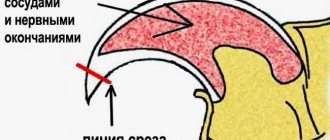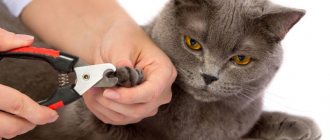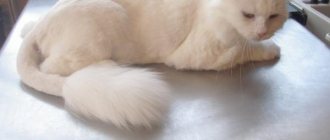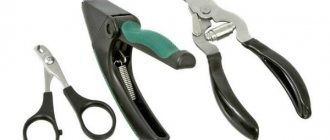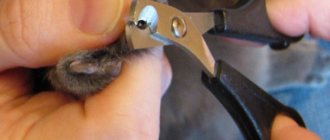Nail salons for cats are not very common yet. And trimming a cat’s claws at home is not difficult at all. Why do many cat owners neglect this procedure?
Some people believe that under natural conditions, cats quite successfully take care of themselves. But it simply doesn’t occur to some people to protect their cat from unpleasant sensations in this way, and their furniture and carpets from sharp claws.
Do I need to trim my cat's claws?
A cat's claws continue to grow throughout their lives and the animal constantly grinds them down so that they do not exceed normal length. Yard cats and those who often walk outside use tree trunks or asphalt for this.
Indoor cats are forced to make do with furniture surfaces and door frames. As a result, scratches are found on them, the coating deteriorates, like upholstered furniture.
Claws that are too long can grow into your cat's paw pads and cause pain when walking. To prevent this, you need to shorten your pet’s claws or purchase a special device - a scratching post. Although in the latter case it is necessary to raise the cat so that he uses it exclusively.
Getting to know the nail clipper
Ideally, your cat should be introduced to this tool at a young age. She needs to stop being afraid of the sound of the nail clipper before you try to use it. A simple exercise will help you.
Place the animal on your lap. Take a piece of uncooked spaghetti and place it in the nail clipper. If the cat's curiosity prevails and forces you to sniff, place a treat on top. Massage the pad of your finger, release the claw and cut the spaghetti. Immediately release your paw and offer your pet a treat so that the click evokes pleasant associations.
Repeat the exercise until you become completely accustomed: you should not start trimming your nails until you achieve complete trust and mutual understanding.
Haircutting tools
Professionals emphasize that the devices from a manicure set are not suitable for this. But they are being a little disingenuous if they say that if used carefully they will not cause harm. Professional clinics use special trimmers, but not everyone has this at home. Therefore, such devices are predominantly used.
Nail cutter - specialized scissors for trimming claws, made of steel.
Guillotine trimmer - ideal for beginners. When you press the handle, a special blade extends, which removes a certain section.
Nail clippers are also suitable for this task, but they need to be held at a certain angle, perpendicular to the nail. If you tilt them at a greater angle, the plates of the claw may begin to peel off, which will lead to injury.
Nail file - used to adjust the shape.
There is a certain limitation for this kind of devices; they must be rigid. Animals have much stronger claws than humans.
Before use, be sure to disinfect the instrument and wipe it with a special antiseptic solution or alcohol. It is also important to stock up on peroxide and cotton wool.
When to trim your nails
For a cat, the procedure is rarely pleasant. For the first time, few pets will allow the owner to not only touch their claws, but also trim them. Therefore, it is recommended to start at an early age. This way the pet can gradually get used to it.
First, you need to pick him up, stroke his paws, lightly pressing on the pads.
So that he does not resist during further actions. You should not cut kittens' claws while playing, when they are excited or hungry. It is best to do this during sleep, or when the kitten is calm.
If during trimming he breaks out, gets agitated, scratches or tries to bite, it is better to postpone the procedure.
How to prepare a cat
You need to catch the best moment for a haircut. It is better for the cat to be sleepy, or at least calm. But you shouldn’t grab it during the game or start the procedure by force. The reaction will be rejection and it will be quite difficult to catch the animal again. The most convenient tools are those with rubber linings; the handles have metal surfaces; your hand can slip. You can reduce the likelihood of traumatic situations by swaddling your pet. This is a fairly effective way to regulate the length of your cat's claws.
You should not expect that your cat will react normally to such a procedure from the very beginning. The claws will have to be exposed by pressing the pad as a result of stroking the paw. This method is especially effective for kittens. They get used to it and no further difficulties arise. At the start, the animal needs to be petted; it is useful to talk to it, calming it down. The cat will need time to get used to this procedure. At this time, the owner should be patient.
During the operation, do not forget to praise your pet, even if he is worried. To alleviate stress, he should be given a vitamin or, better yet, a treat. This will get him a little used to the idea that a haircut isn't so bad.
Nail trimming procedure
The procedure itself does not look scary if you prepare for it correctly and follow the recommendations.
Basic Rules
Before starting the procedure, you must wash your hands and thoroughly sterilize the instrument. The next steps are as follows:
- Hold the paw so that it does not slip out, do not press too hard, the touch should be gentle.
- Press down the pillow a little so that the claw appears.
- If you look closely, you can see that the claw has pinkish tissue inside. This is a pulp, it contains nerves and blood vessels, it cannot be touched. The edge is cut so that there is at least 2 mm to the pulp. If the claws are dark, you will have to act blindly, in several approaches, cutting off 1 mm each time.
- The trimmer should be held perpendicular to the top, trying to cut what you need at a time. This is a matter of habit; after a while everything will happen easier and faster. At the end of the procedure, the edges should be adjusted to make it more comfortable for the pet to walk and avoid injury.
- For the first time, you can use the help of another person to hold the cat. Sometimes in furry breeds, heavily grown hairs can cover the claw. This is where a clipper will come to the rescue if the cat is not afraid of it.
All claws should be trimmed; there are 5 of them on the front paws and 4 on the hind paws. Many often forget about such asymmetry, and without making sure, they leave the old claw, which over time begins to cause pain.
How often to perform the procedure
The best interval is 2 weeks between nail trimmings. This figure varies for each pet, which is influenced by the following factors:
- Nail growth rate . It varies from person to person and depends on nutrition and the presence of sufficient calcium.
- Color . Dark claws grow more slowly.
- Lifestyle . Cats are different, some can be lazy or very active. The latter often play and quickly wear down their claws. Lazy pets require more frequent grooming.
- Participation in inspections and exhibitions . Pedicure before the show is mandatory. But to avoid injury, you have to calculate the length of your swing. The usual 2-3 millimeters may be too much, especially after several days have passed from the previous haircut. You must act carefully.
When is it better to reschedule the procedure?
There are situations when it is better to delay the procedure. If the animal breaks free, you should not take the scissors, this will increase the risk of injury, and you can even twist the paw.
In weakened and sick cats and pregnant cats, stress can aggravate the situation.
It happens that the pet's mood changes and he does not break free. In this case, you will have to put up with cutting off 1-2 claws at a time.
How to trim the nails of an aggressive cat
Not all cats like such manipulations, so owners are often concerned about how to trim the claws of an aggressive animal. To do this, you must follow these rules:
- Find the moment when the cat is in the calmest state.
- To ensure your pet's safety, it should be swaddled. This solution is the most convenient for animals with a difficult character.
- The subsequent steps of the procedure do not differ from the usual one. During the entire process, you should pet and praise your pet.
How often should you trim your nails?
It would be convenient if with each animal the owner was given instructions - what to feed, when to bathe, how to play... in practice, each owner gains skills through trial and error. Based on the experience of owners and veterinarians, we can conclude that the frequency of claw trimming depends on a number of factors, and here are just some of them:
- Lifestyle – a cat that goes outside has the opportunity to actively grind its claws. Lazy couch cats need more frequent manicures.
- Genetics – Some pets are prone to extremely rapid nail growth.
- Balanced diet - if the diet lacks microelements, claws grow more slowly.
- The presence of cat accessories - scratching posts , special rugs and posts with which the cat plays, this is a tool for grinding down the claws.
- Pigmentation - it is believed that light claws grow faster than dark ones.
The rate of nail growth for each cat is individual and depends on a number of factors. Shearing is carried out strictly as needed, on average once every 2–4 weeks.
A word of caution - don't trim your pet's nails just for convenience. Unfortunately, some owners often trim their cats' claws out of fear for the integrity of the furniture or injury. It is better to think about material damage before getting a cat, and if you are afraid of serious scratches, you need to raise a pet.
There is an alternative, although not the best, but quite adequate - caps for claws . Silicone caps are attached with glue and serve as a temporary measure, for example, to ensure the safety of a child while meeting a cat.
Possible complications after cutting nails
In addition to cutting tools, it is advisable to have some medications with you: hydrogen peroxide, iodine and baby powder.
An inexperienced owner can injure his paw, this is unpleasant, but there is no need to panic. If blood bleeds while grooming a cat, you should fill the wound with peroxide and calm the patient down. The bleeding stops in a short time.
After this, you can sprinkle the damaged area with talc or zinc oxide powder.
Before each use, treat scissors and nippers with an antiseptic solution.
What if it doesn't work out?
It is possible that the cat will turn out to be too obstinate, and many days of efforts and tricks to accustom it to manicure will be in vain. In this case, contact a specialist at a veterinary clinic or grooming salon. But keep in mind that such visits can be stressful for a furry creature.
Think about what exactly you didn’t like about the cat’s claws? If the problem is solely in scratched furniture and wallpaper, purchase several scratching posts, saving your pet from negative emotions.
Alternative methods
It is not necessary to cut your cat's claws every time; there are other methods to shorten them or remove them completely.
The methods are chosen independently, depending on the conditions of the animal’s keeping and individual preferences.
Surgical method of removal
The procedure is indicated only for cats that live in an apartment and do not go outside. Even if in the summer the animal goes to the country with its owners, surgical removal is not suitable for it. This is due to the fact that the animal may remain defenseless against other aggressive cats.
Surgery is chosen only for young cats, because the animal needs to learn to do without claws as quickly as possible and the healing process is better in this case. Any chronic disease in an animal may be contraindications.
Covers for claws
An alternative to a haircut can be anti-scratches. They are silicone caps made of soft plastic. They are attached to the claws using a special glue, which is absolutely harmless and does not cause discomfort to the animal.
The uniqueness of this device is that the cat will be able to continue doing its favorite thing - sharpening its claws on furniture, but there will be no destruction, and its instincts will be preserved. In this case, the cat will not even be able to injure the child.
How to prepare for the procedure
The owner must know how to prepare for pruning. Most pets initially resist pruning with all their might. It is important to properly prepare your animal. It is better to choose a time when he is relaxed and in a good mood. You need to start with a paw massage so that the pet does not feel discomfort. Attention switches to other activities and objects.
In the first months, the kitten experiences fear, fear and even irritation. It can break free and run away, and if held by force, it can even bite or scratch a person.
You should not use physical force, as it is necessary to convince your furry pet that this procedure is absolutely safe for him, that he has nothing to be afraid of. Trimming should be done regularly; the animal will gradually get used to it.
Over time, a habit will appear, and to make this happen faster, you can use encouragement in the form of something tasty. In order for pruning to be taken calmly, you should not expose your pet to stress. The owner should talk to him affectionately and stroke him. If the cat is too scared, it is better to postpone the procedure.
